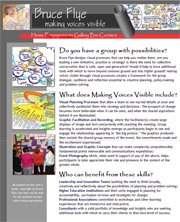
Part of our rationale in choosing this model was based on the assumption that food service operators should be able to quickly grasp the systems analysis with which the process begins. In 2007 we actually struggled with this piece moreso than any others, so a redesign was in store this time around. Here, we mixed very simple approaches with modest requirements for results, and when this was coupled with the extraordinary work effort that NACUFS members bring to these events the results were incredible. Dubious at first, they all saw their sticky notes transition from chaos to order.
One of the struggles I currently have with this particular approach is that it begins with a deficit orientation; in fact, most of the training I've had so far in systems thinking emphasizes problem-seeking. Rather than just sell Ackoff short, attention was called to that issue as they were asked to reflect on how heavy the atmosphere was as we "designed the mess." We also asked for their own experiences in dealing with positively focused issues as opposed to the usual negative orientation.
 They toughed through relatively mindfully, and continued their solid work. The mission statements they developed were as good if not better than most I've seen in the "real world," and they produced them with a minimum of wordsmithing. As they discovered the need for collaboration among groups, they began with a few representatives at first, and eventually entire teams were pairing up to work through issues. The systems thinking approach apparently helped them, as their proposals and solutions clearly had an eye on the total campus context, and not just dining.
They toughed through relatively mindfully, and continued their solid work. The mission statements they developed were as good if not better than most I've seen in the "real world," and they produced them with a minimum of wordsmithing. As they discovered the need for collaboration among groups, they began with a few representatives at first, and eventually entire teams were pairing up to work through issues. The systems thinking approach apparently helped them, as their proposals and solutions clearly had an eye on the total campus context, and not just dining.
We introduced them to a variety of tools. A trends analysis was done by assembling and analyzing a large collage made from magazine clippings. We used Creative Problem-Solving as a reference for careful sequencing of the work, and then added some fast brainwriting to quickly seed idea sessions. CCL's Visual Explorer was used with one group to write the story of "the mess," and with another to help start the Idealized Design. Rather than use the traditional gap analysis to move from Idealized Design to Means Planning, we borrowed from Appreciative Inquiry and helped them collaboratively write P rovocative Propositions.
rovocative Propositions.
It's often the case after an event like this that we go home full of excitement, but then it passes in the face of the next week's demands. To confront this head-on, we designed a set of reflective questions, based in concept on the Dream stage in AI but blended with Idealized Design, and asked them to work in pairs to write and share a story about what the next year would be like for each of them. Some of the thoughts we heard were:
- The quote I'll remember: It's easier to tame down a wild idea than to wild up a tame one;
- The provocative propositions work was really nice. We NEVER write down these thi
ngs;
- I have a great team! I can do this! Let's think bigger!
- Sometimes a peak experience begins with a setback;
- We're all in this together;
- I can start my own story now;
- A cookie cutter approach is not what we did this week. Thank you, Bruce!


No comments:
Post a Comment